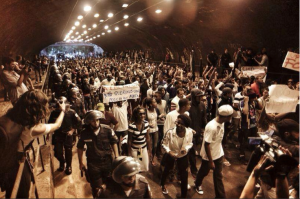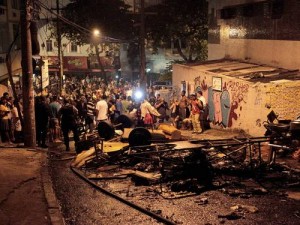 An increase of violence in Pavão-Pavãozinho and Cantagalo over recent months–neighboring favelas located above the beachside neighborhoods of Ipanema and Copacabana in Rio’s South Zone–combined with the high profile death of a widely known and loved young man this past week have led to an uprising and widespread resident questioning of the effectiveness of the Pacifying Police Unit (UPP) there. PPG, as the three adjoining favelas are collectively known, has been pacified since December 2009. However, the UPP program there has seen many forms of mismanagement since the unit was implemented, leading to distrust between residents and police forces. Community leaders and residents are calling for an end to the violence. Since the year began, the community has seen an increase in violence including police brutality. The most recent event, now bringing the situation to a head, being the death of a rising dancer and actor, Douglas Rafael da Silva Pereira, known as DG, on April 22nd. Shortly after the discovery of DG’s body on Tuesday morning community residents claimed DG was beaten to death by police, and intense protests began demanding justice and an explanation for the young man’s death.
An increase of violence in Pavão-Pavãozinho and Cantagalo over recent months–neighboring favelas located above the beachside neighborhoods of Ipanema and Copacabana in Rio’s South Zone–combined with the high profile death of a widely known and loved young man this past week have led to an uprising and widespread resident questioning of the effectiveness of the Pacifying Police Unit (UPP) there. PPG, as the three adjoining favelas are collectively known, has been pacified since December 2009. However, the UPP program there has seen many forms of mismanagement since the unit was implemented, leading to distrust between residents and police forces. Community leaders and residents are calling for an end to the violence. Since the year began, the community has seen an increase in violence including police brutality. The most recent event, now bringing the situation to a head, being the death of a rising dancer and actor, Douglas Rafael da Silva Pereira, known as DG, on April 22nd. Shortly after the discovery of DG’s body on Tuesday morning community residents claimed DG was beaten to death by police, and intense protests began demanding justice and an explanation for the young man’s death.
Recent Uprising Sparked by DG’s Death
On Tuesday, April 22, DG, a 26-year old actor and professional dancer on Globo’s “Esquenta” TV show, was found dead at a local day care in Pavão-Pavãozinho. DG recently played the protagonist in the short film, “Made from Brazil”, who is killed by police. A tragic coincidence, the actual death of DG happened in the same favela where the film was shot less than a year after it was produced.
Shortly after the discovery of DG’s body on Tuesday, residents protested, accusing the UPP of beating DG to death. The 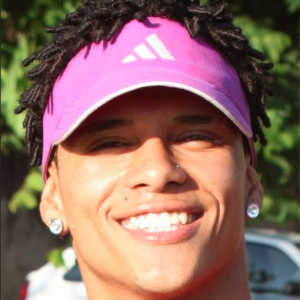 circumstances of his death are still unclear and under investigation, however it was claimed that DG’s body was found with boot marks, suggesting he had been kicked to death; a police report claimed his wounds were comparable to a death caused by a fall. His mother, Maria de Fátima, commented to O Globo that “his body was full of boot marks. His back, all scratched, and the walls of the nursery, which are roughcast, bloody. The UPP doesn’t protect anyone. We live in a regime of arbitrariness. We want whoever did this to my son to be punished.” Residents believe that the day before, DG had jumped over a wall to hide from a confrontation between police and drug traffickers and that police confused DG as a gang member and beat him. He was heading into Pavão-Pavãozinho to visit his four year-old daughter. The UPP has not yet confirmed this information or commented.
circumstances of his death are still unclear and under investigation, however it was claimed that DG’s body was found with boot marks, suggesting he had been kicked to death; a police report claimed his wounds were comparable to a death caused by a fall. His mother, Maria de Fátima, commented to O Globo that “his body was full of boot marks. His back, all scratched, and the walls of the nursery, which are roughcast, bloody. The UPP doesn’t protect anyone. We live in a regime of arbitrariness. We want whoever did this to my son to be punished.” Residents believe that the day before, DG had jumped over a wall to hide from a confrontation between police and drug traffickers and that police confused DG as a gang member and beat him. He was heading into Pavão-Pavãozinho to visit his four year-old daughter. The UPP has not yet confirmed this information or commented.
Later on Tuesday, residents from Pavão-Pavãozinho marched to a local police station demanding an explanation for DG’s death and protested by setting barricades and cars on fire blocking the main access street to the favela. Shortly after, shots between local bandits and the police began. Police claim the shootings were initiated by a local criminal gang and retaliated with tear gas and stun-grenades. During the shooting, a 27-year old man, Edilson Santos, was killed with a shot in the head and there are claims that a 12-year old boy had been shot. On Twitter a post stated, “What will be the excuse this time? That the innocent person the UPP killed was a suspect, that he had suspicious attitudes, that he was in a confrontation with the police, that he was an ex-trafficker? One more innocent dead, one more mother without a son, one more child without a father.”
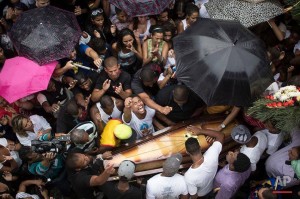 On Thursday, April 24, at the entrance of Pavão-Pavãozinho, a demonstration in memory and for the justice of DG and Edilson Santos occurred and protesters then marched to the cemetery where DG was buried. The demonstration had over two hundred people in attendance, carrying signs saying “Police assassinated DG and Edilson, victims of the state!” and questioning “How many more are going to die, UPP?”
On Thursday, April 24, at the entrance of Pavão-Pavãozinho, a demonstration in memory and for the justice of DG and Edilson Santos occurred and protesters then marched to the cemetery where DG was buried. The demonstration had over two hundred people in attendance, carrying signs saying “Police assassinated DG and Edilson, victims of the state!” and questioning “How many more are going to die, UPP?”
At one point during the protest, police forces attacked protesters, who got increasingly angry as a result, with batons and tear gas. In a video of the protest, one resident commented about the UPP, “They come up to disrupt and to end lives and dreams and happiness of families in the community, so, how are we supposed to accept this project here continuing with the name of pacification? When truthfully, they are entering prepared for a war, a war against people who are tired from a past of war and fighting. They are entering and bringing yet more war.”
Before the events of the past week, however, social movements in PPG had already been springing up in response to recent months’ violence in the community. A young resident who chose not to share his name commented, “It’s barbarian what is starting… Exchanges of gunfire almost all of the nights. It’s starting to happen again because the police don’t know how to act and don’t know how to work. It’s generating a revolt. It’s going to continue, going to sustain until the World Cup, after the World Cup.”
This recent conflict with the UPP originated from a string of violence involving the Red Command (Comando Vermelho) gang, after the gang’s chief, Adauto do Nascimento Gonçalves, also known as Pitbill, received the benefit of a periodic home visit in June of 2013 after being imprisoned since 2009. Pitbull did not return to prison and has been on the run since last June.
Since the beginning of 2014, violence picked up in Cantagalo as police search for Pitbull. In mid-January, according to the Coordinator of Pacifying Police (CPP), police were attacked by armed criminals, with gunfire and homemade bombs. On January 17, Petrick Costa dos Santos, 21, died following the confrontation with UPP officers. He had been spotted by UPP officers with an Israeli gun and shots were immediately exchanged. The following day’s commerce was highly regulated; police checked every car and moto-taxi that entered the favela.
The following week on January 24, shots were fired when police reached what they believed was the location for Pitbull, and the Red Command headquarters. Two members of the gang were caught in this exchange and Pitbull escaped. In March there were a number of shootings between police and traffickers. In early April, protests began in front of the Ipanema metro station after two men were shot, one of whom was a trafficker according to police. Throughout a number of these operations the BOPE (Military Police Special Operations Battalion) was brought in. The conflict on this past Monday originated when police again believed they found the location of Pitbull and other gang members. DG was accused of being a member of the gang.
“The UPP is a hoax, a lie”
Even before the last week’s death of DG and the uprising sparked as a result, residents felt there was a lack of respect from the UPP. Social activist, Deize 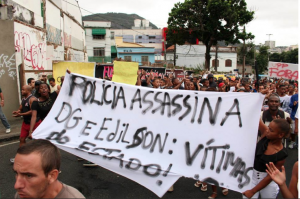 Carvalho, born and raised in Cantagalo, is strongly against violence in the community. After the death of her son Andrew, 17, in January of 2008, who was assassinated and tortured by agents of DEGASE (General Department of Social and Educational Actions), Deize joined the city-wide movement of families with innocent members killed by police, the Network of Communities Against Violence. The network works to document cases, call for justice and fight against violence in defense of human rights to prevent other families from having to go through the loss of loved ones due to violence. Deize said, “The majority of people don’t have a good relation, don’t have a closeness with the UPP. We already had experience with police. And we don’t want the UPP.”
Carvalho, born and raised in Cantagalo, is strongly against violence in the community. After the death of her son Andrew, 17, in January of 2008, who was assassinated and tortured by agents of DEGASE (General Department of Social and Educational Actions), Deize joined the city-wide movement of families with innocent members killed by police, the Network of Communities Against Violence. The network works to document cases, call for justice and fight against violence in defense of human rights to prevent other families from having to go through the loss of loved ones due to violence. Deize said, “The majority of people don’t have a good relation, don’t have a closeness with the UPP. We already had experience with police. And we don’t want the UPP.”
Pavão-Pavãozinho and Cantagalo have already known a history of police action that aims to combat violence and trafficking. Residents had hoped the UPP would be different and they would see change in the community. Now, however, a number of residents have lost hope that the program can have any form of success in Cantagalo and Pavão-Pavãozinho. Resident, Filipe Barbosa, 22, commented, “Pacification was fast, one thing after another. When we realized it the favela was full of police inside. It was sinister, it was sinister. Disaster came. Then the BOPE came here.” In a YouTube video posted after the protests in Pavão-Pavãozinho on Tuesday night, one resident said in regards to the implementation of the UPP, “I thought it was going to improve, that my grandson, that the new generation that is arriving now, would not see more arms, more drugs. But everything is getting worse.” Many residents were hopeful that change would come and that after the installation of the UPP, social programs would also arrive.
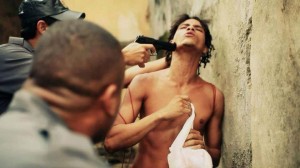 Residents, now more than ever are questioning the effectiveness of the UPP program. DG’s mother, Maria de Fátima, stated, “The UPP is a hoax, it’s a lie.” Already prior to DG’s death, Deize expressed her frustration, saying, “Now, I don’t know how [the UPP] can have a positive impact…If they didn’t come here in violent form, if they came here…really to do good for the community, I believed it could have changed. I believed that it was going to improve. I wanted it to improve. But in the first week, I could see they really came like the second Elite Squad [movie].” Deize, very passionately, continued, again in an interview prior to DG’s death, “It should’ve been the opposite, when the police arrived in the community. (It should’ve been) beautiful, everything’s great, how marvelous that we don’t have shootings. Lies. People who don’t live in the favela don’t know what the residents go through.”
Residents, now more than ever are questioning the effectiveness of the UPP program. DG’s mother, Maria de Fátima, stated, “The UPP is a hoax, it’s a lie.” Already prior to DG’s death, Deize expressed her frustration, saying, “Now, I don’t know how [the UPP] can have a positive impact…If they didn’t come here in violent form, if they came here…really to do good for the community, I believed it could have changed. I believed that it was going to improve. I wanted it to improve. But in the first week, I could see they really came like the second Elite Squad [movie].” Deize, very passionately, continued, again in an interview prior to DG’s death, “It should’ve been the opposite, when the police arrived in the community. (It should’ve been) beautiful, everything’s great, how marvelous that we don’t have shootings. Lies. People who don’t live in the favela don’t know what the residents go through.”
In recent protests, some residents have made reference to the UPP being as violent as a criminal gang by referring to the UPP as Comando Azul (Blue Command), saying “Red Command or Blue Command, what difference does it make?” Although violence has existed previously in the community, residents blame the UPP for the recent growth. Deize commented, “Violence always existed in the community. But now that the police pacified it, this violence grew because the government is using propaganda to show what it wants. When you see a (police) representative on television that says that a good bandit is a dead bandit, they are showing what the police are doing in the community.”
The perspective that a good bandit is a dead bandit and the lack of respect in police approaches of innocents leads to the distrust and disrespect between community members and police. The criminalization of poverty that results from this approach is leading some to question whether, for the community, the UPP is better than what preceded it. A young resident of Pavão-Pavãozinho who chose not to share his name said, “It’s not an issue of traffickers in the favela. Traffickers, when residents arrive, have respect. The guy is going to respect us. The UPP doesn’t. The UPP arrives and is in your face, punches you in your face, gun in your face and that’s not okay. It’s for this reason that the UPP is not respected.” He continued, “The UPP, in some places is good. But in other places, its bad because of the ignorance. They don’t know how to arrive guaranteeing rights, they don’t know how to work with rights, so in these places I prefer the UPP leave the favela. [Maybe] if the UPP came to the favela to help and build bonds and remained calm, but the UPP came to the favela to kill and wants to accuse residents who have nothing to do with the trafficking.”

